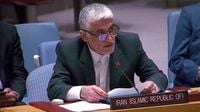On August 22, 2025, the already volatile borderlands of southern Syria were thrust back into the international spotlight as Israeli military forces carried out a series of high-profile incursions into the governorates of Quneitra and Daraa. According to Syria’s state-run SANA news agency, Israeli army patrols advanced from the occupied Syrian Golan into local villages, setting up checkpoints, searching homes, and detaining several civilians before later releasing them. The events, which unfolded in the towns of Abidin and Al Ajraf, have reignited longstanding tensions over sovereignty, occupation, and the fragile peace maintained since the 1974 disengagement agreement between Syria and Israel.
The details of the incidents are stark. In the early hours, a patrol of six Israeli military vehicles entered the town of Abidin, situated in the Yarmouk Basin west of Daraa. Local sources told SANA that three young men were arrested by the Israeli forces. The patrol subsequently left the area, and the detainees were reportedly released later that day. Not long after, four more Israeli army vehicles advanced into the village of Al Ajraf in Quneitra. Soldiers searched a number of houses and established a military checkpoint at the village entrance, a move that residents saw as both provocative and deeply unsettling.
These actions, Syrian officials argue, represent a blatant breach of the 1974 disengagement agreement—brokered to prevent direct military clashes between Israel and Syria after the Yom Kippur War—as well as an ongoing violation of international law and United Nations resolutions affirming state sovereignty. The continued presence and activity of Israeli forces inside Syrian territory, they contend, have only served to inflame local anxieties and complicate an already tangled regional situation.
Neighboring Iran was quick to denounce the latest developments, using the platform of the United Nations Security Council to amplify its criticism. On August 21, Iran’s permanent ambassador to the UN, Amir Saeid Iravani, delivered a forceful speech in which he condemned Israel’s “repeated acts of aggression against civilians and vital infrastructure in Syria.” Quoting Iravani, the Iranian news agency reported, “The Security Council should not ignore the ongoing destabilizing actions of the Israeli regime in Syria.” He went on to assert, “Israel’s repeated aggressive attacks have caused civilian casualties, destroyed vital infrastructure, and escalated regional tensions.”
Iran’s position is unambiguous: it “categorically rejects any attempt to undermine Syria’s sovereignty, alter its demographic composition, and fragment its territory.” Iravani called for an immediate end to Israel’s occupation of the Syrian Golan, describing it as “a violation of international law, the UN Charter, and the Security Council’s resolutions.” The ambassador also warned about the persistence of terrorism in Syria, flagging the ongoing threats posed by groups such as Da’esh and Al-Qaida, which, in his words, “continue to destabilize Syria and the entire region, seriously undermining regional and international peace and security.”
For many observers, the Iranian ambassador’s remarks highlight a broader diplomatic impasse at the United Nations. While the Security Council has repeatedly affirmed Syria’s territorial integrity in principle, enforcement remains elusive. Iran’s call for a “Syrian-led and Syrian-owned political process” as the only sustainable path forward underscores the frustrations of regional actors who see outside interventions—whether from Israel, the United States, or Turkey—as obstacles to a lasting resolution.
Yet the situation on the ground is far more complex than a simple contest between sovereignty and occupation. Since the ouster of Syrian President Bashar al-Assad, the regime in Damascus has, according to some sources, been effectively controlled by Hay’at Tahrir al-Sham (HTS), a militant group led by Abu Muhammad al-Jolani with well-established ties to Da’esh and al-Qaeda. Rather than mounting a robust resistance to the Israeli advances, HTS’s apparent inaction and reported normalization overtures toward Tel Aviv have, critics argue, emboldened Israeli forces to intensify both their occupation and bombardment campaigns.
Israeli officials, for their part, have justified their deployments and operations in southern Syria as necessary counterterrorism measures. According to multiple reports, Israeli forces now maintain at least nine posts deep inside Syrian territory, most of them within the UN-monitored buffer zone. The stated rationale is to counter the threat posed by Takfiri militants and other extremist groups operating in the area. However, detractors—including Iran and Syria—contend that these deployments serve as a cover for a broader strategy of territorial expansion, achieved through a combination of military aggression and settler incursions.
Meanwhile, the humanitarian cost continues to mount. Israel has escalated its bombardment of both military and civilian infrastructure across Syria, further destabilizing the region and exacerbating the suffering of ordinary Syrians. According to Iranian diplomatic sources, these attacks have “systematically weakened Syria’s ability to resist occupation and defend its sovereignty.” The destruction of infrastructure—from bridges and roads to hospitals and power plants—has left communities across southern Syria grappling with shortages of essential goods and services, deepening the sense of crisis.
For residents of Quneitra and Daraa, the latest Israeli incursions are just the most recent chapter in a long saga of conflict and uncertainty. Many have lived for years under the shadow of occupation, displacement, and sporadic violence. The sudden arrival of military vehicles, the searching of homes, and the arbitrary detention of civilians have become grimly familiar features of daily life. “We just want to live in peace, but every time it seems like things might calm down, something like this happens,” said one local resident, speaking on condition of anonymity for fear of reprisals.
Internationally, responses to the crisis remain divided. While Iran and its allies have condemned Israel’s actions in the strongest terms, Western governments have largely focused on the broader security challenges posed by extremist groups in Syria, often sidestepping the issue of territorial violations. The United Nations, for its part, continues to call for restraint on all sides and the resumption of meaningful peace talks, but progress has been slow and halting.
As the situation in southern Syria evolves, the stakes remain high—not just for the immediate communities affected, but for the wider region. With multiple actors pursuing competing agendas, and with the fabric of Syrian society stretched to the breaking point, the prospects for a peaceful resolution appear as distant as ever. For now, the residents of Quneitra and Daraa must navigate the perilous realities of occupation, conflict, and an uncertain future.
Amid shifting alliances and ongoing hostilities, the latest Israeli incursions serve as a stark reminder of the fragility of peace in the region—and of the urgent need for renewed diplomatic engagement to prevent a further slide into chaos.




